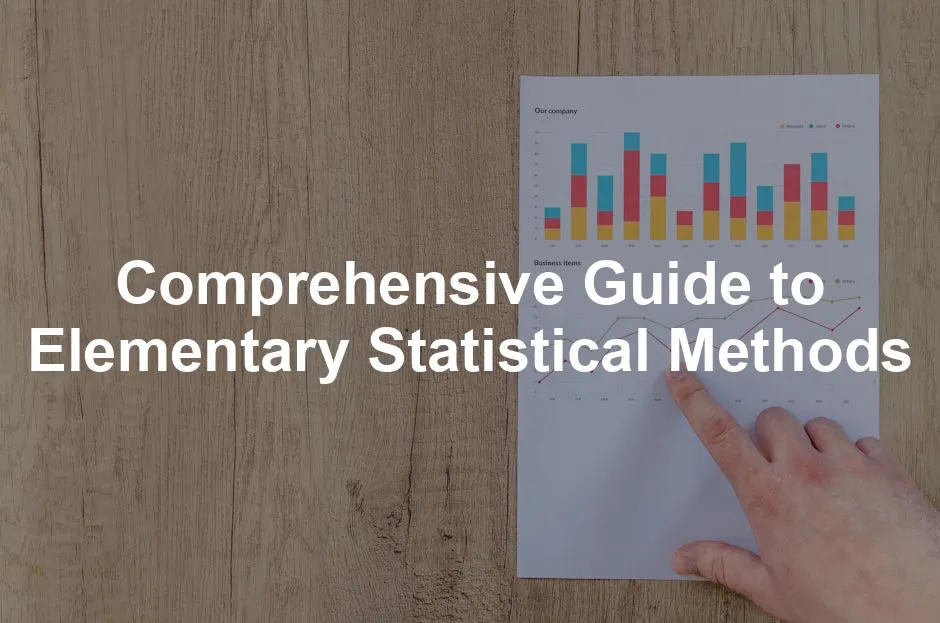Introduction
Elementary statistical methods form the backbone of data analysis. They are essential tools that help us summarize, interpret, and draw conclusions from data. These methods are not just for statisticians; they play vital roles in diverse fields like business, psychology, and education.
In business, for instance, elementary statistics inform marketing strategies. Companies analyze customer data to determine what products people want. This data-driven decision-making can lead to increased sales and customer satisfaction. In psychology, researchers utilize these methods to analyze survey results or experimental data, helping them understand human behavior better. Education also benefits, with teachers assessing student performance through standardized tests and surveys.
Mastering elementary statistical methods is crucial for making informed decisions. Misunderstanding statistics can lead to poor choices, while a solid foundation allows for more accurate interpretations of data. This understanding helps individuals navigate through the sea of information presented in today’s data-driven society.
If you’re looking for a comprehensive resource to get started with these concepts, consider picking up “Elementary Statistical Methods” by Sahana Prasad. It’s a fantastic guide for beginners and seasoned statisticians alike!
This article will provide a comprehensive overview of elementary statistical methods. We will cover fundamental concepts, key terminologies, and real-world applications, equipping you with the knowledge to apply these methods effectively.

For a deeper understanding of statistical learning, check out this article on an introduction to statistical learning with Python.
Understanding Statistics
What is Statistics?
Statistics is the science of collecting, analyzing, and interpreting data. It can be divided into two main branches: descriptive and inferential statistics. Descriptive statistics summarize data from a sample using means, medians, modes, and standard deviations. They provide a snapshot, making complex data sets easier to understand.
On the other hand, inferential statistics allow us to make predictions or generalizations about a larger population based on a sample. This branch is vital in fields like healthcare, where researchers might predict disease outcomes based on a sample group.
Statistics are everywhere! In marketing, companies analyze consumer behavior to tailor their products. In healthcare, statistical methods help in understanding treatment effectiveness. Even in sports, teams rely on statistics to evaluate player performance and devise strategies.
If you’re serious about diving deeper into statistical methods, you might want to check out Statistical Software R Programming for Data Science. It’s a fantastic tool for analyzing data like a pro!
Key Terminologies
Understanding statistics starts with familiarizing yourself with key terms.
- Population: This refers to the entire group of individuals or items that we want to study. For example, all students in a university.
- Sample: A sample is a subset of the population. If we take 100 students from that university, that’s our sample.
- Variable: A variable is any characteristic that can vary among individuals. For instance, age, height, or test scores.
- Parameter: This is a numerical value summarizing a characteristic of a population, like the average GPA of all students.
- Statistic: A statistic is a numerical value summarizing a characteristic of a sample, such as the average GPA of the 100 students we sampled.
By grasping these fundamental terms, you can better understand the principles of statistics and how they apply in various contexts. Statistics may seem daunting at first, but with these basic concepts, you’re well on your way to becoming data savvy!

Core Concepts in Elementary Statistics
Elementary statistics provides essential tools for understanding and interpreting data. In this section, we will explore descriptive statistics, which summarize and describe data, along with data visualization techniques that help us present this information in a digestible format.
Descriptive Statistics
Measures of Central Tendency
Measures of central tendency summarize a set of data by identifying the central point within that dataset. The three most common measures are the mean, median, and mode.
Mean: This is the average of all data points. To find it, sum all values and divide by the total number of values. For example, if you have test scores of 80, 90, and 100, the mean is (80 + 90 + 100) / 3 = 90. The mean is useful in providing an overall score but can be affected by extreme values. To learn more about what mean means in statistics, visit what does mean identically distributed in statistics.
Median: The median is the middle value when data points are arranged in order. If the dataset is 1, 3, 3, 6, 7, 8, 9, the median is 6 (the fourth value). If the dataset has an even number of values, the median is the average of the two middle numbers. This measure is particularly helpful when dealing with skewed distributions, as it isn’t swayed by outliers. For insights on median salaries in Poland, check out statistics Poland median salary 2024.
Mode: The mode is the value that appears most frequently in a dataset. For instance, in the dataset 1, 2, 2, 3, 4, the mode is 2. The mode is useful in understanding the most common value, especially in categorical data, where we want to know which category appears the most. For a comprehensive understanding of residuals statistics, see statsmodels residuals statistics.
Measures of Variability
While measures of central tendency tell us about the typical data point, measures of variability inform us about the spread of the data. The most common measures of variability are range, variance, and standard deviation.
Range: This is the difference between the highest and lowest values in a dataset. For example, in the dataset 5, 10, 15, 20, the range is 20 – 5 = 15. It provides a basic understanding of the spread but can be overly simplistic.
Variance: Variance measures how far each data point in the set is from the mean. A high variance indicates that data points are spread out over a wider range of values, while a low variance shows they are clustered closely around the mean. For instance, a set of test scores with a variance of 0 means every score is identical.
Standard Deviation: The standard deviation is the square root of the variance. It also measures the average distance of each data point from the mean. A small standard deviation indicates that the data points tend to be close to the mean, while a large one indicates they are spread out over a wider range. This measure is particularly useful because it is in the same units as the data points, making it easier to interpret.
Understanding variability is crucial because it provides insights into the consistency and reliability of the data. For instance, in quality control, a high standard deviation in product weights may indicate serious production issues needing attention. If you’re looking to keep your data organized, consider using a graph paper notebook to jot down your findings!

Data Visualization Techniques
Graphical Representations
Visualizing data helps communicate findings more effectively. Various graphical methods serve this purpose, including histograms, pie charts, and scatter plots.
Histograms: These are used to represent the frequency distribution of numerical data. Each bar represents the frequency of data points within a specific range. For example, if you wanted to display the distribution of ages in a class, a histogram would illustrate how many students fall into each age range. They provide a clear view of the data’s distribution and can reveal patterns over a large dataset.
Pie Charts: Pie charts display data as sections of a circle, representing proportions of a whole. For example, if a survey asked people their favorite fruit, a pie chart could show the percentage of respondents favoring apples, oranges, or bananas. While they are visually appealing, pie charts can sometimes be less effective for comparing differences in sizes, especially when sections are similar in size.
Scatter Plots: These plots show the relationship between two numerical variables. Each point represents an observation, with its position determined by the values of the two variables. For example, a scatter plot could illustrate the relationship between hours studied and test scores. Patterns in scatter plots can indicate correlations, and they are particularly useful in regression analysis.
To enhance your data visualization skills, consider reading “Data Visualization: A Practical Introduction” by Kieran Healy. It’s a great resource to help you present your data effectively!
In conclusion, understanding the core concepts of descriptive statistics and effective data visualization techniques empowers us to interpret data accurately and convey insights clearly. Mastering these tools is essential for anyone looking to make informed decisions based on data analysis.

Probability Basics
Understanding Probability
Probability is a measure of uncertainty. It quantifies the likelihood of an event occurring. In statistics, it’s a fundamental concept that helps us make sense of randomness. Think of it as a way to predict outcomes based on known data.
For example, if you flip a coin, there are two possible outcomes: heads or tails. The probability of getting heads is 0.5, or 50%. This simple calculation is the essence of probability.
Now, let’s talk about independent and dependent events.
- Independent events are those where the outcome of one event doesn’t affect the other. For instance, flipping a coin does not influence the outcome of rolling a die.
- Dependent events, however, are linked. If you draw a card from a deck and do not replace it, the outcome of your next draw is affected. The probabilities change based on previous outcomes.
Understanding these concepts is crucial. They lay the foundation for analyzing data and making informed decisions based on statistical evidence. For a comprehensive guide on probability in genetics, check out mendelian genetics probability pedigrees and chi-square statistics.
Probability Distributions
Probability distributions describe how probabilities are distributed over values. They’re essential for statistical analysis. The two most common distributions are the normal distribution and the binomial distribution.
- Normal Distribution: This is often called the bell curve. In a normal distribution, most values cluster around a central peak, and probabilities taper off symmetrically on either side. This distribution is vital in statistics because many real-world phenomena follow this pattern, like heights or test scores.
- Binomial Distribution: This distribution applies to situations with two possible outcomes, like success or failure. For example, if you’re flipping a coin multiple times, the binomial distribution helps calculate the probability of getting a certain number of heads in those flips.
Using these distributions allows statisticians to model data effectively. They provide insights into trends and help in making predictions about future events based on historical data. Such tools are invaluable in fields ranging from healthcare to finance, where understanding probabilities can lead to better decision-making.
In summary, grasping the basics of probability and its distributions is essential for anyone looking to understand statistics. These concepts provide a framework for interpreting data and forecasting outcomes, making them a cornerstone of statistical analysis.

Applications of Elementary Statistical Methods
Elementary statistical methods are not just confined to textbooks; they have a profound impact across various fields. Let’s take a closer look at how these methods are applied in real-world scenarios, showcasing their significance in decision-making and analysis.
Real-World Examples
In healthcare, elementary statistics play a crucial role. Hospitals utilize statistical methods to monitor patient outcomes. For instance, a study might analyze recovery rates from a specific surgery across different demographics. By applying statistical tools, healthcare providers can identify which factors lead to better recovery rates and adjust their practices accordingly. One notable example is the use of statistics to track the effectiveness of vaccines during clinical trials, ensuring they work as intended before public distribution.
In business analytics, companies rely on statistics to make informed decisions. Consider a retail store analyzing sales data. By applying regression analysis, they can predict future sales based on past performance. For instance, if sales spike during holiday seasons, businesses can adjust inventory levels proactively. A case study in this realm showed that a popular clothing brand utilized statistical methods to optimize their supply chain, reducing waste and increasing profits significantly.
In the social sciences, statistical methods help researchers understand complex social phenomena. Surveys often collect data that require careful analysis. For example, a sociologist studying the impact of education on income levels would use inferential statistics to draw conclusions from a sample population. This allows them to generalize findings to a larger group, aiding in policy development. A compelling case involved a study on educational attainment and its correlation with employment rates, leading to significant insights for policymakers.

Importance of Statistics in Decision-Making
Statistical literacy is not just for statisticians; it empowers everyone to make informed decisions. When individuals understand the basics of statistics, they can critically evaluate the data presented to them. For instance, when reading news articles that cite survey results, a statistically literate person can assess the validity of the findings based on sample size and methodology.
However, misinterpretation of statistics can lead to disastrous consequences. Consider the infamous case of misleading statistics used in political campaigns. A candidate might present cherry-picked data to sway public opinion, leading voters to form opinions based on flawed information. This highlights the necessity of understanding statistical principles to safeguard against manipulation.
In conclusion, the applications of elementary statistical methods are vast and impactful. From healthcare to business and social sciences, statistics provide the tools necessary for informed decision-making. As we continue to navigate a world inundated with data, mastering these fundamental techniques becomes increasingly essential for both individuals and organizations alike.

Challenges and Misconceptions in Statistics
Common Misunderstandings
Statistics can be a tricky business. Many folks walk into their first stats class thinking it’s all about crunching numbers. But let’s set the record straight. A common pitfall is confusing correlation with causation. Just because two trends move together doesn’t mean one causes the other. For example, ice cream sales and drowning incidents may both rise in summer, but that doesn’t mean ice cream causes drowning. It’s just a seasonal coincidence!
Another misunderstanding is believing that statistics only involve complicated math. While some aspects do require calculations, many statistics concepts are more about critical thinking. You need to ask questions like, “What does this data really show?” or “What assumptions are we making?” Otherwise, you risk falling prey to misleading graphs or cherry-picked data.
Critical thinking is essential when interpreting statistical data. The ability to evaluate the validity of data sources and the methodology behind them can prevent someone from being misled. In today’s world, where statistics permeate every aspect of life—from news reports to social media—developing a critical mindset toward data is vital. So, the next time you see a statistic, don’t take it at face value. Ask yourself what lies beneath the surface.

Overcoming Challenges
If statistics feels like a foreign language, you’re not alone! Many learners struggle with this subject. Here are some tips to help you navigate the statistical maze. First, practice, practice, practice! Use exercises and problems to reinforce your understanding. Websites like Khan Academy and Coursera offer great materials for free.
Second, don’t hesitate to ask for help. Study groups can work wonders. Sharing ideas and tackling problems together can solidify your grasp of complex concepts. If you prefer a more structured approach, consider enrolling in online courses that focus specifically on elementary statistics.
Finally, utilize tools and resources that simplify the process. Statistical software like R or Python libraries can help you conduct analyses without getting bogged down by calculations. There’s also a plethora of textbooks, such as “Elementary Statistical Methods” by G. Barrie Wetherill, which can guide you through the basics.
In summary, overcoming difficulties in statistics involves a mix of practice, collaboration, and leveraging technology. With the right mindset and resources, you can conquer the challenges and unlock the vast world of data analysis.

Conclusion
In this blog post, we’ve explored the fascinating yet often misunderstood realm of elementary statistical methods. We began by highlighting the importance of statistics in various fields, from business to healthcare. A solid grasp of these concepts can empower individuals to make informed decisions, analyze trends, and interpret data effectively.
We’ve also tackled common misconceptions that can lead to confusion. Understanding the difference between correlation and causation is crucial, as is developing critical thinking skills when interpreting data. Statistics is not just about numbers; it’s a tool for understanding the world around us.
Finally, we discussed ways to overcome challenges in mastering statistics. By practicing regularly, seeking help, and utilizing modern tools, anyone can learn to navigate the complexities of data analysis. Remember, the journey to statistical literacy is a rewarding one, opening doors to new insights and opportunities.
If you’re looking for a reliable tool to assist with your calculations, consider investing in a Graphing Calculator TI-84 Plus CE. It’s a fantastic companion for any statistics student!
Please let us know what you think about our content by leaving a comment down below!
Thank you for reading till here 🙂
FAQs
What are elementary statistical methods used for?
Elementary statistical methods are vital across various fields. In business, they help analyze market trends and customer behavior. In healthcare, they assess treatment effectiveness and patient outcomes. Educators use these methods to evaluate student performance. Even policymakers rely on statistics to inform decisions. Essentially, these methods provide the foundation for making sense of data in our everyday lives.
How do I start learning statistics?
Starting your statistics journey can be as simple as picking up a good textbook or enrolling in an online course. Resources like Khan Academy or Coursera offer free introductory courses. Look for study groups in your community or online forums. Engaging with others can deepen your understanding. Most importantly, practice regularly to build your confidence!
Are calculators necessary for statistics?
While calculators can simplify calculations, they aren’t strictly necessary. Many statistical concepts can be understood without them. However, for more complex analyses, statistical software or graphing calculators can be extremely helpful. Tools like R and Python can automate calculations, making analyses quicker and more efficient.
What are some common statistical mistakes to avoid?
Common mistakes include misinterpreting data or ignoring sample size. Always consider whether a sample is representative of the population. Avoid using misleading graphs that distort data. Finally, remember that correlation does not imply causation; just because two variables move together doesn’t mean one causes the other. Being aware of these pitfalls can help you navigate statistics more effectively.
All images from Pexels




